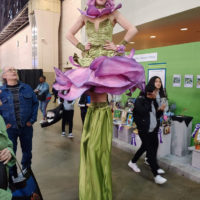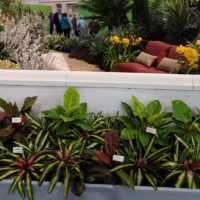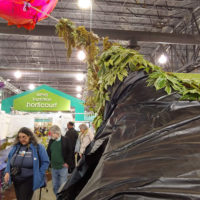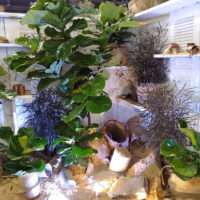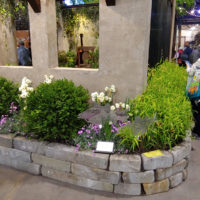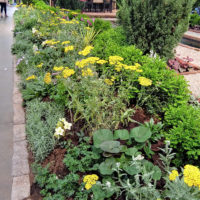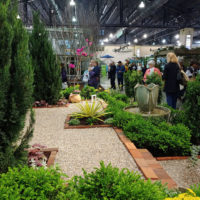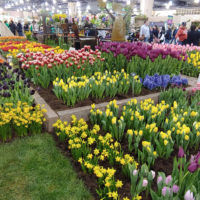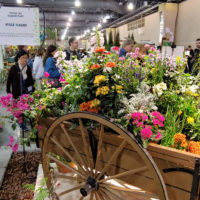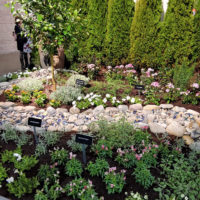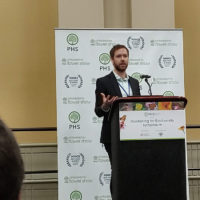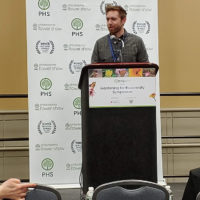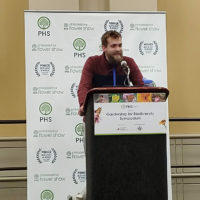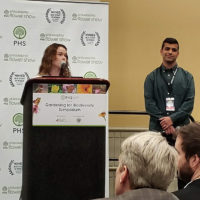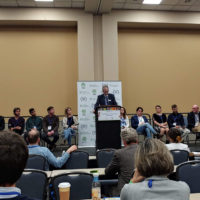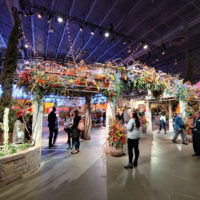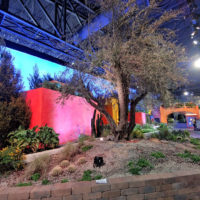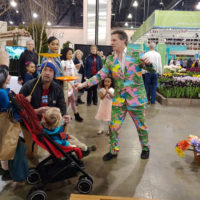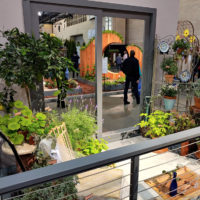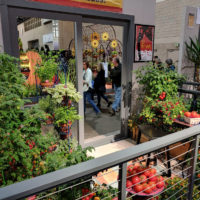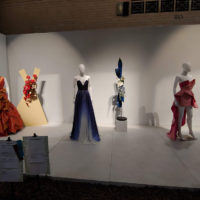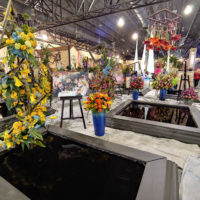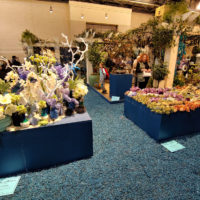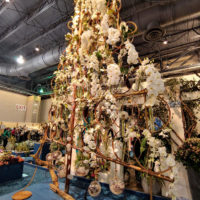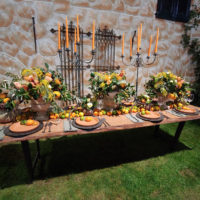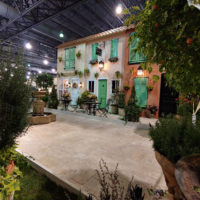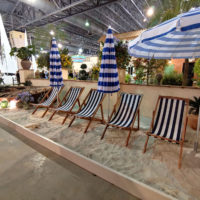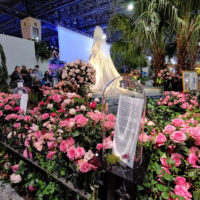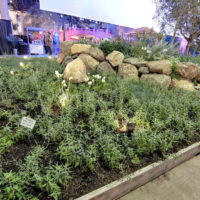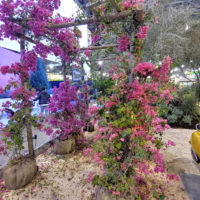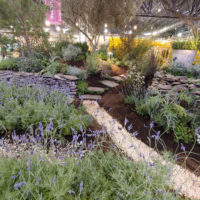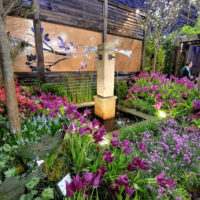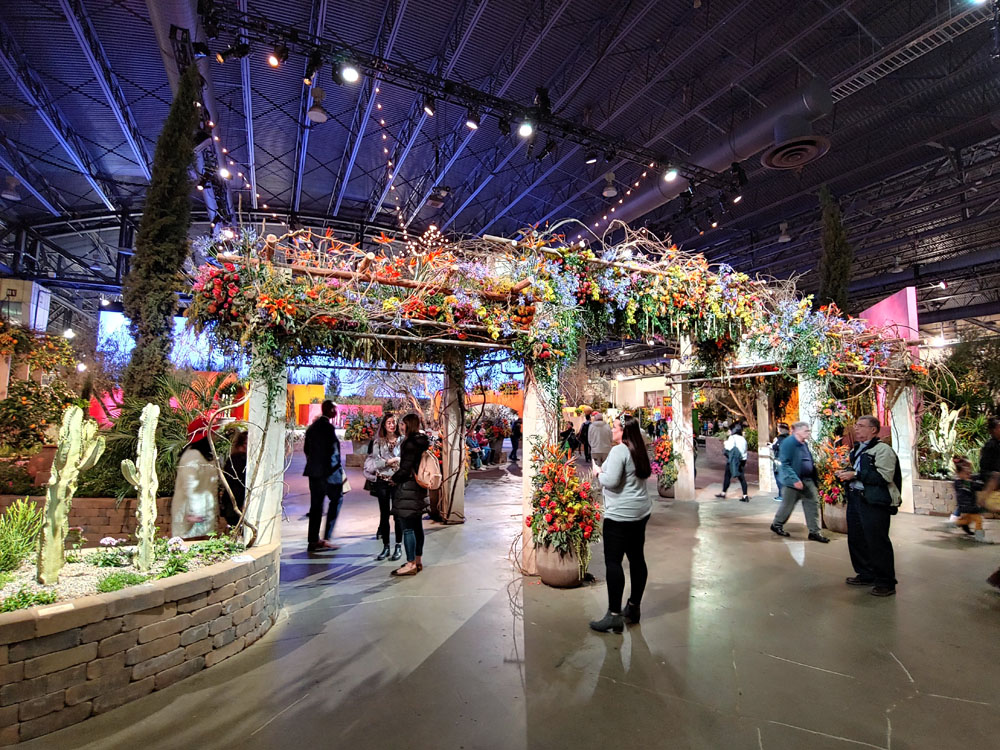
Last year was the first year I attended the Philadelphia Flower Show – it was an incredible display of artistry and offered a wealth of information about plants, gardening, industry professionals and products. I LOVED it and decided it was a spectical not to be missed moving forward.
This spring, I looked for tickets to the flower show and discovered an experience they were offering that I definitely wanted to take advantage of. The show was going on from February 29 to March 8th. On Wednesday, right in the middle of event an upgraded ticket included the PHS Gardening for Biodiversity Symposium. This was an all day event from 8:30am to 5pm. The venue space was on the lower level of the convention center, in the same building as the show, which was taking place upstairs. The symposium included professional and experienced speakers from around the world talking about food forest gardening, gardening for climate change, rare and endangered plants, green roofs, landscaping with native plants, sustainable development goals, orchids, soil microbes and more!
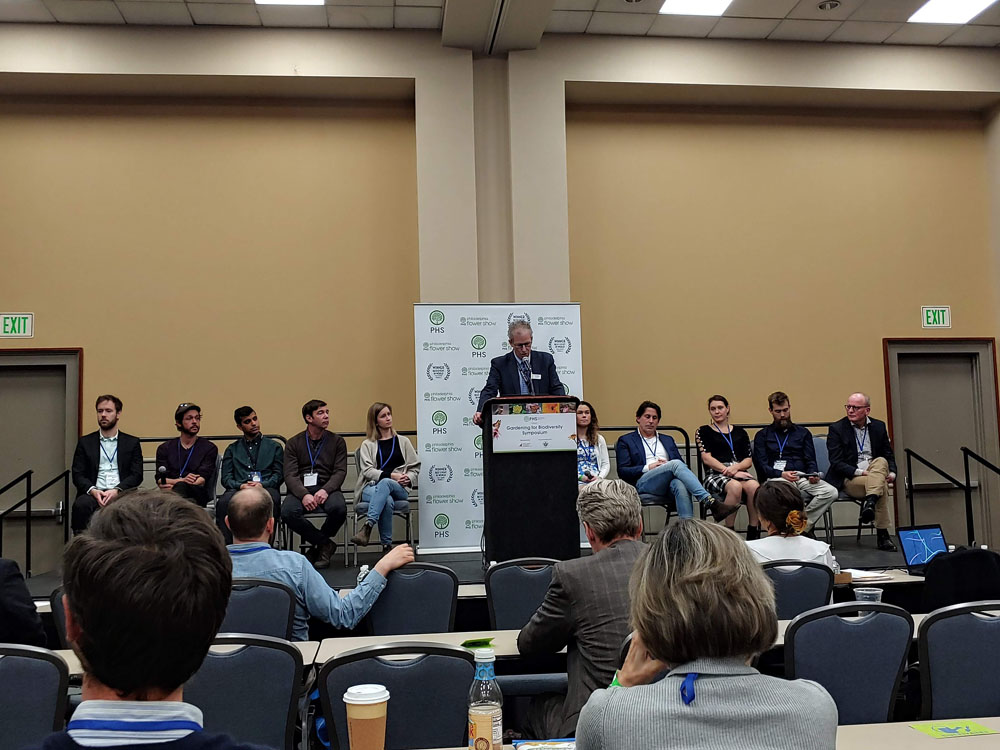
The symposium took a break for lunch and the day included 2 question and answer periods so that attendees had the opportunity to interact with the speakers about their presentations.
I wanted to take note of the interesting and helpful points presented by the speakers during the event.
Unfortunately I missed the first speaker, as I am not familiar with the geography of Philadelphia and I was on my own, looking for appropriate parking before the event. Appalled by the first public lot I found with a $30/day price tag, I continued about for 20 minutes before settling on one closer to the entrance of the event which unfortunately set me back $36 for the day. I know Philly can be a rough neighborhood and I didn’t want to have any trouble finding me car at night, so I shrugged it off and found a spot on the 7th floor of the parking deck, 1/2 a block away.
By the time I found my seat, the first speaker, Dr. Peter Raven from the Missouri Botanical Garden had just finished his talk via a teleconferencing session on a large screen. All the other speakers were present that day.
[su_row][su_column size=”1/2″ center=”no” class=””]
Abby Meyer from Botanic Gardens Conservation International, spoke about Garden-based solutions to the plant extinction crisis. The organization works with 3000 gardens worldwide and focuses attention on species and regions that need it the most. She grew up in Nebraska on a farm and mentioned that 1 to 2 hours of labor goes into each quart of tomato sauce. She spoke about the research and resources available at botanical gardens.
Dr. Dennis Whigham from the Smithsonian Environmental Research Center and the North American Orchid Conservation Center spoke next. He discussed the ecology and conservation of native orchids. There are 25,000-30,000 different species of orchids – the most species rich plant genre on earth. Only about 1000 have been assessed and about 60% are in trouble. The US has 200 species and 57% of them are endangered or extinct!
[/su_column]
[su_column size=”1/2″ center=”no” class=””]
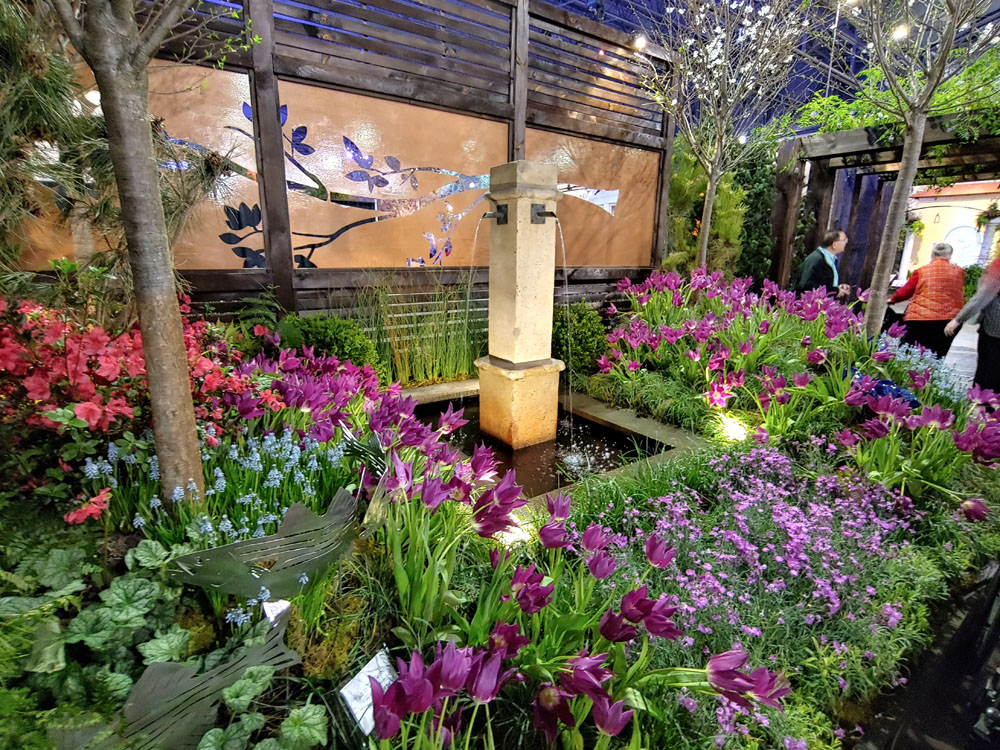
[/su_column][/su_row]
Some orchids offer animals no reward for pollination. They fool male insects by looking like female insects. Males come to mate and pollinate the flower!
Orchids rely on fungi in every stage of life. Orchid seeds are tough and they can last a long time in the soil – in his studies, seeds stayed viable in the soil for 13 years (and counting). Orchids can be dormant for up to 30 years below ground. Photocorm and dormant stages are non-photosynthetic.
The goal is to conserve genetic diversity of our native orchids. They want to get seeds from anywhere the orchids appear and send them to repositories for native orchid seeds, even though, at this point NO ONE KNOWS how to germinate the orchid seeds. Doesn’t that seem crazy? No people have every recorded a reliable method to germinate orchid seeds… EVER?!
The North American Orchid Conservation Center is a good resource and the http://goorchids.northamericanorchidcenter.org/ is a database of all native orchids in US and Canada.
[su_row][su_column size=”1/2″ center=”no” class=””]
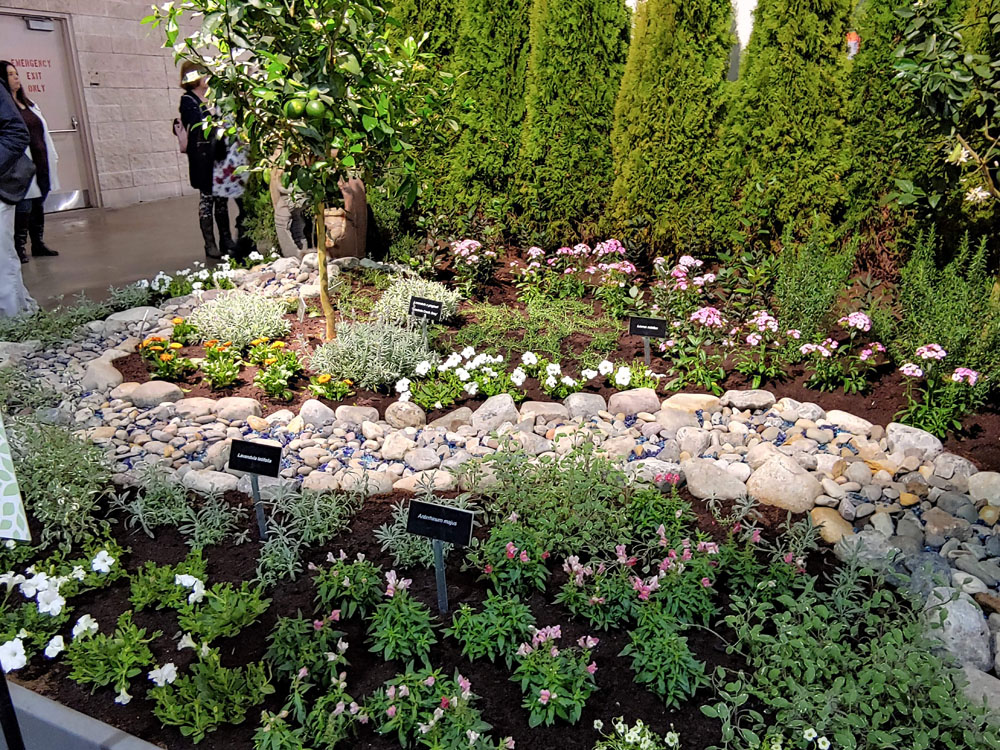
[/su_column]
[su_column size=”1/2″ center=”no” class=””]
Sam Keitch from the Pennsylvania Horticultural Society spoke about the public gardens he has helped to design, established and maintain on behalf of PHS. A major project they recently completed was for the new Subaru national headquarters in Camden, NJ. They planted 53,000 plugs of native plants from North Creek Nurseries for this project. He endeavors to use more grasses and perennials as a dynamic layer in current landscape designs.
Billy Brown from the Philadelphia City Nature Challenge told us about the iNaturalist app. It’s a helpful app for those who want to identify plants or wildlife they find while out in public or wild spaces. The app autogenerates suggestions based on user submitted photos or “observations”. You can select a suggestion to identify your observation and then other users can confirm your identification.
[/su_column][/su_row]
Observations can be added to “projects” in the app. This app is being utilized by groups to organize global “Bioblitz” events – where users try to catalog everything that lives in a place in a short period of time. This kind of data helps scientists deepen their understanding of biodiversity in a particular watershed or ecological area. It’s not intended to be used for things you’ve planted intentionally – if you do add something cultivated as an observation, be sure to flag it as such.
The City Nature Challenge is a global competitive Bioblitz. Philly made quite a showing last year, and reached their goal to beat Tokyo. This year, they want to be San Francisco and LA.
These speakers participated in a question and answer period and then we were all set loose to find what we wanted to have for lunch. This was when I ventured upstairs, flashing my wristband to gain entry, and rushing across the flower show display floor to get in line with one of the food vendors. We only had an hour for lunch before the next speakers took the stage and I needed to make sure I could find something gluten free. I picked up a prepackaged salad and bottle of water and took a slow stroll back to the room, now that I had secured sustenance. The garden installations were fantastic.
[su_row][su_column size=”3/5″ center=”no” class=””]
The theme of the event this year was The Riviera, so there were old world looking facades with architecture adorned with floral displays, table settings, beach scenes and even fashion inspired designs. I struggled to equate desert motifs and succulents with The Riviera, but the visuals were well executed. The abstract non-representational displays don’t thrill me, but it was never something I related to when I attended fine art school, either. Meh. Not for me. No written description could possibly to justice to the combinations of colors, shapes and textures compiled in these beautiful and temporary displays. Please browse the photos I’ve included in the post to see just a small part of the artistry that was accomplished.
This time there were street performers, walking on stilts and spinning plates for passers by. A nice touch of authenticity that added to the ambiance.
After lunch, back at the Gardening for Biodiversity Symposium, Debra Goldstein, Esq from the Philadelphia Environmental Film Festival spoke about the event scheduled for April 1st through 5th. If Covid-19 concerns have caused the event to be postponed, I do hope they reschedule accordingly. This year’s festival includes 310 films from 42 countries. She also mentioned that 26 of the films are by female directors and she provided a generous discount code for tickets for this audience.
[/su_column]
[su_column size=”2/5″ center=”no” class=””]
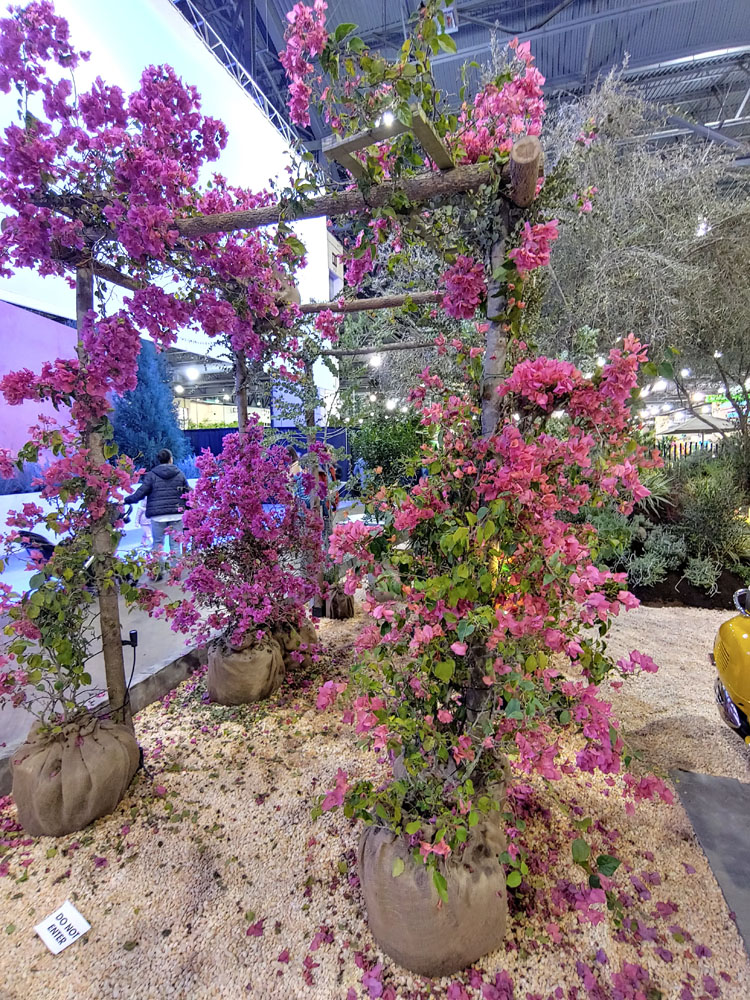
[/su_column][/su_row]
Dr. Colin Averill from ETH Zurich presented Seeing the Forest for the Fungi, Restoring the Soil Microbiome. In this enlightening talk, he reiterated the idea that trees sharing resources via common Mycorrhizal fungi networks. Did you know there are two kinds? Ecto and arbuscular. Very few trees form relationships with both, they tend to be either/or. When working toward forest restoration, it’s important to know the kind of fungi present and plant trees that associate with that type.
Doug Muller from Hudson Valley Seed Company, who also had a retail booth selling seeds at the Flower Show, spoke next about seed biodiversity in your garden and on your plate. He reminded us that food meets ecology in a practical way every day. Seed saving has been the engine that brought stability to civilization.
Something I never thought about before was the “globalized diet”. Diets have become more diverse, but seeds have become less diverse. People eat a wider variety of types of food than were every previously available (mangoes and avocados and dragon fruit, etc) because of preservation and transportation – but the commercially available varieties of crops have narrowed considerably in the last 100 years because of consumer demand, shelf stability, packaging and shipping concerns and more. Some of the foods we have gotten used to eating are not adapted to the region. We are all eating from the same industrialized food system which ultimately limits the biodiversity available to consumers. This is problematic for resiliency if there are major disruptions in infrastructure or climate, the less we are able to adapt.
Save your seeds! The fewer people who are seed saving, the more it’s left in the hands of professionals. Historically, it’s been up to everyone to save seeds and pass along genetic diversity. After the symposium was over and I spent some time walking through the stands of the vendors at the flower show, I found Doug and talked to him about
Jeff Lorenz and Melissa Nase from Refugia Ltd. spoke about Designing Native Landscapes. So many of the questions I’m asked on social media revolve around native plant selections to add to the yards of friends and family. This pair of professionals insist that homeowners can have native and diverse landscapes that are beautiful and functional. When beginning a project with a new client they devise plant palettes up front and present them with a variety of colors and textures including extended bloom times. They seemed to specialize in meadow installations and extol the virtues of including water and wind into the design. They want to hear the landscape as well as see, smell and touch it.
They are passionate about spreading the idea of gardening with natives and endeavor to create an ecological greenway network. A wildlife corridor to reestablish wildlife habitat. The National Wildlife Federation has a plant finder website that includes information aggregated by Doug Tallamy regarding the number of insects that depend on each plant as food and host for young.
They suggested that the Bottlebrush Buckeye may be a good replacement in the landscape for the invasive butterfly bush. I’ll have to try to source one of those as I have a butterfly bush that I wouldn’t mind removing.
Doug Sponsler from the Penn State Center for Pollinator Research and Academy of Natural Sciences at Drexel University is an entomologist who talked about choosing flowers that feed bees. His research revealed that there are gaps in resources from late July to frost so Philadelphia residents should plant things that bloom then. Most flowers for most of the year are on trees and shrubs. Which plants stand out? Red maple, willow, woody vines and woody perennials.
Dr. Julianna Razryadov from Phipps Conservatory spoke about Green Roofs: The New Frontier for Biodiversity. Sedum is a good choice for green roof plantings because they can photosynthesize without losing much water and can survive in less than ideal conditions. Green roofs often have just 2 to 4 inches of growing medium designed to be light weight, retain moisture and make it easy for roots to spread. Green roofs make solar panels work more efficiently because they cool them off by lowering the temperature on rooftops. Solar panels benefit the green roof installation because they create shade and seed banks for biodiversity on the roof.
Holly Gallagher from the National Wildlife Federation and Samir Dalal from Philadelphia LandCare and PHS talked about their efforts to install garden and park like spaces in vacant lots throughout Philadelphia. Natural spaces improve physical and mental health and reduce gun violence. They are installing butterfly gardens to create habitat in areas with little support for butterflies. They communicated the appalling statistic that 80% of all the butterfly species are projected to be extinct in the next 20 to 30 years.
[su_row][su_column size=”1/2″ center=”no” class=””]
Michael Muehlbauer from the Philadelphia Orchard Project spoke about Food forest Gardening and the Web of Life. I filmed his talk instead of taking notes since his was the reason I wanted to attend the symposium in the first place. Michael and I spoke briefly afterwards and it sounds like they have lots of food forest development projects in the works within Philadelphia. I’d love to visit them to see their progress. Check their site to volunteer or attend future events.
The owners of NL Greenlabel came to talk about measuring the sustainability of urban gardens with NL Greenlabel. They spoke about quantifying sustainability by determining what nature is worth? Materials, transport and plants are part of what’s considered when determining Sustainable Development Goals. They mentioned solar parks with native plants and playground equipment, solar fields installed with native meadows to create habitat and reduce the need for lawn mowing and maintenance around the panels. They are releasing a garden app to be launched this spring.
[/su_column]
[su_column size=”1/2″ center=”no” class=””]
[/su_column][/su_row]
After the question and answer period was over, there was a reception (additional ticket price) on the floor of the flower show where attendees could gather. They served wine and light refreshments and I spoke with a PHS organizer and picked up a couple of seed bombs of north east natives that were give-aways for garden lovers!
I’m so glad I went and that I was able to attend before social distancing became important in our area. For now, we stay put and delay gathering in with lots of other humans. I will spend time with my immediate family while we are all home, commune with nature and care for my garden with a renewed purpose of resilience and biodiversity!
Be well, my garden friends!
https://theflowershow.com/

